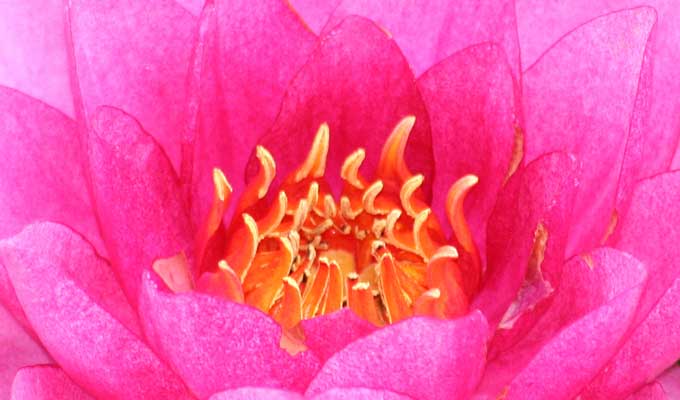A Devotional Practice
In the silence I asked, “To whom shall I surrender?”
In answer I heard, “To your being–to heart,
the self that is love.”
Spontaneous meditation is, for me, a multi-faceted gem. Because quieting the mind is essential, I call this practice a “meditation,” but the act of offering oneself to heart is integral, too. For this reason, spontaneous meditation may also be described as a devotional path. In fact, the silent awareness that arises during spontaneous meditation creates the field—the environment—in which full devotion flowers.
The Essence of Devotion
Examples from Hinduism, Islam, Taoism and Christianity reveal the core of a devotional approach to spirituality: in order to commune with their source—with That which gives them life—devotees everywhere offer themselves, freely and with love, to this sacred, all-enfolding power.
In India, the devotional path to God is called bhakti yoga. The word, “bhakti” comes from the root “bhaj,” meaning “to share.” The basic idea behind the bhakti path is that God promises to impart something of divine consciousness to devotees—to the extent that they offer themselves to God, sincerely and lovingly.
Mira, a sixteenth-century poet in the bhakti tradition, lived out this promise through devotion to God in the form of Krishna. Through her poetry, we see Mira offer herself fully—her body, her life—to Krishna, knowing that, in exchange, he will respond and draw near to her, for he has promised to do so.
Hoping to merge with Krishna’s consciousness, Mira gives him everything. She offers her mind, her life’s breath, her fear of reincarnation. She even offers specific, human hurts, like the pain she suffers at the hands of her quarrelsome mother-in-law. Filled with tears, she surrenders herself at Krishna’s feet.
At first Krishna does not return Mira’s love. Although she offers herself “wholly” and “forever,” sometimes her pride gets in the way. But Mira does not give up. Again and again, she calls, asking Krishna to come to her quickly.
In time, Krishna runs to meet Mira and returns her love. She offers a thousand thanks as her beloved takes up residence in her heart. Now, as she soaks in his love, her mind and body dissolve in him.
The devotional path also has its followers in Islam. In the Koran, for example, God describes a direct path to him, saying:
My servant draws near to me with ceaseless devotion until I love him. And when I love him, I am the hearing with which he hears, the sight with which he sees,the hand with which he smites, the foot he walks on.
Studying this passage line by line, reveals the elements of devotion:
“My servant”: The person about whom God speaks knows that God creates and sustains all life; he also wants to be an instrument of God’s will.
“draws near to me with ceaseless devotion”: The seeker offers himself to God without interruption. Through constant self-giving, he moves into intimate relationship with God.
“until I love him”: God’s servant offers himself again and again until God responds with love.
“And when I love him, I am the hearing with which he hears, the sight with which he sees, the hand with which he smites, the foot he walks on”: Through God’s love, the person’s perceptions and actions are made holy. God and the devotee are now joined; they are as one.
In China, more than 2,000 years ago, a legendary figure named Lao Tzu wrote a mystical treatise called the Tao Te Ching, a primary source for contemplative Taoism. Although Lao Tzu’s path is not usually spoken of as a devotional one, his manuscript also portrays an exchange of gifts between spiritual seekers and an infinite, all-pervading power.
In Chung-yuan’s translation of Chapter 16 of the Tao Te Ching, for example, Lao Tzu tells us to “devote” ourselves to the eternal, infinite Void—to the Tao. This is easy to do because the Tao—our Great Mother—gives birth to us, nourishes us, comforts and protects us. Knowing this, everyone spontaneously honors and loves the Tao (Chapter 51, translated by Mitchell).
Very few enter into intimate relationship with the Tao, however; only a few ever allow themselves to be fed, like a newborn, by the Great Mother. This deepest of bonds begins to form when an individual identifies with the Tao. In response to this identification, the Tao gladly welcomes each new seeker (Chapter 23, trans. Wei). But the Tao cannot give the seeker everything until she has given up everything (Chapter 22, trans. Mitchell). When she becomes completely empty, the Tao fills her with its light.
Christian devotees also enjoy exchanging gifts with God. This theme is present, for example, in the writings of the fifteenth-century German mystic, Mechthild of Magdeburg. Mechthild had many dialogues with God—dialogues that she recorded. At one point in their conversations, God offered her a simple exchange, saying: if you give me everything that is yours, I will give you everything that is mine.
Mechthild records the stages in her evolving relationship with God. In one scene, she comes to God bearing a gift. When she asks where to put her treasure, God tells her to place it in his divine heart. Mechthild lays her gift in God’s heart and they embrace, like “two lovers.” But they do not remain permanently in each other’s arms, for Mechthild’s self-giving is intermittent. She, like most of us, learns to offer herself in increments.
Later, Mechthild enthusiastically declares her desire for God and her expectation of their immediate union. But God tells her to wait; it is not yet time for their marriage. Mechthild wonders what is left to give and God tells her that all thoughts of “me” and “mine” must go. She then wonders what will become of her if she gives up her self, but God reassures her, and she finds even more of her self to give.
As Mechthild moves toward God, God moves toward Mechthild. She describes the ease with which God offers himself, saying that his love flows toward man like a bird gliding on air currents. Eventually, their exchange becomes a union, a spiritual marriage in which the two join as one.
For Mechthild, their union is not the end of her self-giving, however. All the love, the nourishment, the joy that God offers her, she must not keep for herself. In order to be like God, she must give everything back to him.”
Spontaneous Meditation
In the 1980‘s, when I first experienced the divine current moving in my body, I did not think of myself as engaging in a devotional practice. I believed, then, that devotees surrendered to an “other”—to someone or something outside themselves. My self-offering, in contrast, was to a living love-stream flowing inside me.
Then, in 1995, I came upon Arthur Osborne’s biography of the twentieth-century Indian sage, Ramana Maharshi, entitled, Ramana Maharshi and the Path of Self-Knowledge. My mind reeled as I read Ramana’s words on devotion: in real bhakti, he declared, devotees surrender the ego to the Self. In that moment, I realized that my spiritual experience of the last fourteen years was not only a meditative practice but also a devotional one, with deep roots in religious history.
With further reading, I learned that spiritual devotion takes many forms. Sometimes the object of devotion is external (God, Mary, Kwan Yin, Buddha), sometimes it is internal (Original Nature, the divine Self, the Kingdom of Heaven Within).** Some devotees offer themselves to an impersonal force (the dynamic ground of being, the Source), others to a person (Krishna, Jesus, a living guru). Seekers’ actions may be called “surrender,” “sharing, “self-sacrifice,” or “self-giving.”
Despite differences in terminology, many devotees would agree, I believe, with the advice recorded in the Bible: “Draw nigh to God and he will draw nigh to you” (James 4:8).
When I practice spontaneous meditation, my devotion is to heart, the fount of spiritual energy that lies at the core of myself and others.+ For me, this energy is love itself, a conscious, radiant current that is always awake, clear, truthful, compassionate and free. Because heart flows inside me, I sometimes call it “the river of love.”
I experience this transcendent stream as both an impersonal force and a personal presence. Usually, I discover this sacred power moving inside me; occasionally, I find myself dwelling within this living stream. In order to avoid the notion of “defeat” implicit in the word “surrender,” I use the term “self-giving” to describe my devotional acts.
During thirty years as a devotee, I’ve learned what other seekers have discovered: when I genuinely offer something of myself to heart, heart imparts something of itself to me. This is a premise upon which spontaneous meditation is based.
During an experience of spontaneous meditation, mental quiet creates the environment in which an exchange with my true nature is possible.
In order to give myself to heart, I must first know myself. This self-knowledge arises through silent, felt witnessing of my interior world. When my mind is filled with thoughts that flit from topic to topic, I cannot pay attention to the subtle sensations arising from my personality—that part of myself that is conditioned by circumstances and is, therefore, unfree. Through feeling, I’m able to access, and therefore to offer, the many aspects of my personality to heart.
What do I offer? I offer myself, either in part (a thought, an emotion, a life situation, a part of the body, a possession) or in entirety (all that I am and all that I own).
Resting in the felt silence also enables me to receive from heart. When I am abuzz with ideas, I cannot pay attention to the sensations arising from my being. Through feeling I can perceive, and therefore receive, what heart wants to give me.
What do I receive? Heart imparts aspects of its own nature: peace, love, wisdom, insight, equanimity, or bliss for example. Most days, I experience heart’s gifts as insights or shifts in consciousness. Sometimes heart brings my personality’s forgotten wounds (guilts, grudges, fears, angers, sorrows) into awareness, so they can be released. At other times, the divine current flows through my body, guiding me into movements and sounds of its own choosing.
Spontaneous meditation is “spontaneous” because both my giving to, and my receiving from, heart are unstructured experiences. Until I quiet my mind and feel, I do not know what I will offer. Whatever arises in the silence (a thought, an emotion, a sensation, a movement) becomes the offering. Similarly, I do not know what heart will give me until I set thought aside and explore myself through my ability to feel. Heart’s gifts (joy, flexibility, balance, clarity, compassion, self-awareness, for example) come to me spontaneously, as a surprise.
Paradoxically, the spontaneity in this kind of meditation requires discipline, for what is exchanged with heart can only be perceived when the mind is still.
Sometimes, when I am about to make an offering to my true nature, I wonder: what does it mean to give myself sincerely? And: am I placing limitations on my giving or my receiving? After years of reflection, I have formulated seven guidelines that make my devotion more full and effective.
First, I enter into devotional practice in order to serve the divine love that dwells in all beings, not just to benefit myself.
Second, while making an offering, I rest in silent awareness and feel. Abiding in this felt silence enables me to access, then to give, something of myself to heart. Remaining in the felt silence also allows me to sense, and therefore to receive, the gifts heart intends for me.
Third, during my exchange with heart, I suspend analysis. When I entrust a gift to my true nature, I do not ask, “Why am I offering this particular gift?”—nor do I interrupt heart’s giving by asking, “Why have you selected this present for me?”
Fourth, I set judgments aside. I do not evaluate whether my gifts to heart (or heart’s gifts to me) are “too small” or “too large,” “appropriate” or “inappropriate,” “beautiful” or “ugly,” for such characterizations disrupt the flow of energy between us.
Fifth, I make sure that my giving is sincere and not a disguised form of discarding or taking. When I make an offering to heart, I give with love and appreciation for our relationship—not because I want to discard something I dislike or because I want to induce heart to give me something I desire. In the same way, when I offer a present to a friend, my attention is on the fondness we feel for each other, not on my wish to get rid of the present or on what I want my friend to give me.
Sixth, in order to be fully open to my true nature, I include in my offerings experiences that my personality—my ordinary, conditioned self—covets. I’m also willing to receive from heart situations that my personality would rather avoid.
To use the language of Buddhism, my giving and receiving are most abundant when I am free of aversions and attachments. Obsessive dislikes and likes disrupt the sharing—the love-exchange—between my ordinary self and heart.
Seventh, although I pay attention to these guidelines, I do not let their mental content take me out of the silence. I know that my primary task is to rest in the divine silence and feel.
In the following poem, I portray the devotional spark that animates spontaneous meditation. These lines record a dialogue between a spiritual seeker and the current of love that flows, river-like, inside her.
Finding My Way
The Seeker:
River of love, giver of life,
how will I find you?
Others approach you
through physical postures,
mental procedures
and visual techniques,
but I come to you
with only myself.
The River of Love:
Quieting your mind,
look deep inside,
then make an offering
of whatever you find.
Analyzing nothing
let go of everything.
No gift is too large
or too small.
Then,
in one fleeting moment,
when you feel and give all,
I’ll rise up inside you,
flooding your pale shell
with my liquid light
and you,
like a ripe pod,
will burst open with life.
Notes
* My understanding of the bhakti path and of Mira’s poetry are taken from The Devotional Poems of Mirabai by A. J. Alston. To create the section on Taoism, I used translations of the Tao Te Ching by Chang Chung-yuan, Stephen Mitchell and Henry Wei. Mechthild’s story is drawn from Enduring Grace: Living Portraits of Seven Women Mystics by Carol Lee Flinders.
** Some seekers new to spiritual life believe that the object of their devotion is external; later, they discover the divine dwelling within their own heart.
+ I write “heart” without a capital letter to emphasize the ease with which we may know our own being.





